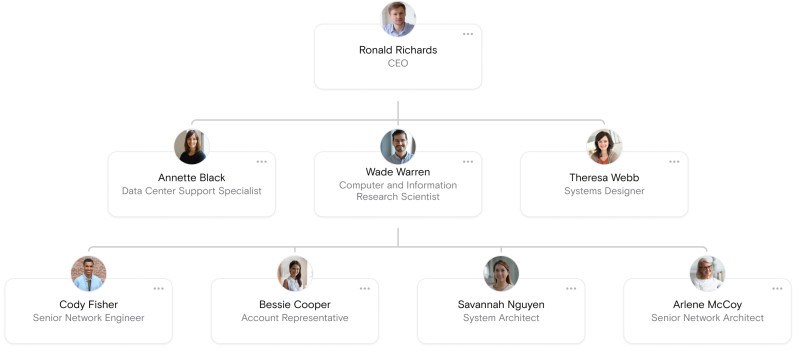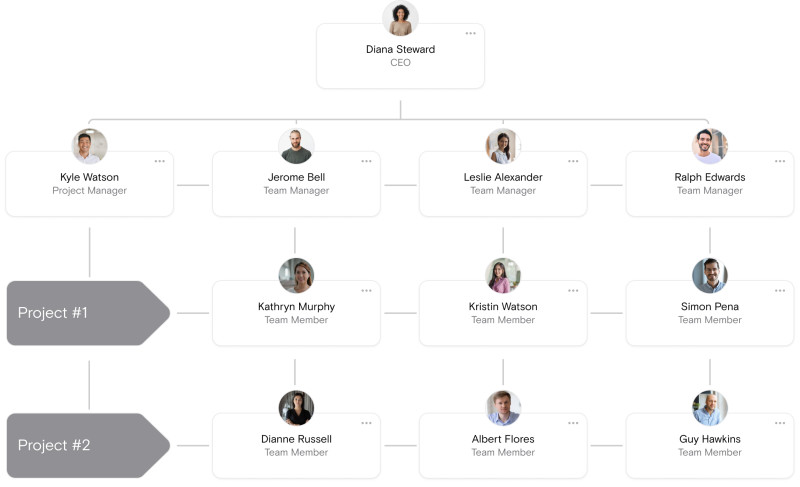Table of contents
An org chart does more than organize your team’s roles & relationships. Learn about the types of org charts, what they’re used for, and how to create your own.
An organizational chart is an important tool for every company — no matter the size. Having a clearly defined org chart can improve communication, increase your chances of turning candidates into colleagues, and convey transparency to the world around you.
An org chart can also be helpful in identifying issues, prioritizing resources, and making the right decisions. But what is an organizational chart, what are its benefits, and how do you create one? In this article, we’ll answer all of those questions.
Let’s dive into it!
What is an organizational chart?
An organizational chart is a visual representation of how your organization is structured. Company organizational charts show the reporting relationships between employees, managers, and executives within teams, departments, or divisions.
Companies can be structured in many different ways, so there are several different types of organizational charts. Some are divided by skill and designed with centralized control for making the best decisions, while others encourage collaboration and distribute autonomy to enable faster decisions. Let’s take a closer look at different types of organizational charts.
Different org charts
Hierarchical org chart

A hierarchical organizational chart is the most common and traditional way of structuring a company. A hierarchical organization is pyramid-shaped with the CEO at the top. The higher up on the chart, the more decision-making power.
Hierarchical org charts have a clear chain of command, as every employee reports to their functional manager above them in the hierarchy. Communication flows from the top down.
This type of organizational structure is found in companies such as Amazon, Walmart, and Coca-Cola where a clear chain of command is necessary for making the right decisions. Contrarily, this structure is rarely seen in startups. Startups will often implement a flatter structure to move faster and avoid the bureaucracy that can arise in the layers of middle-management.
Functional org chart
In a company that operates under a functional organizational chart, employees work in different departments, each having a functional head. Unlike a hierarchical chart, employees are organized by their expertise rather than by decision-making authority.
As each employee is not individually managed, functional organizational designs allow for more flexibility and autonomy within each department, while still keeping a short chain of command to the head of each department.
Matrix org chart

A matrix organizational chart is defined by employees reporting to both their functional manager above them in the hierarchy _and _a cross-functional manager at a horizontal level in the organization. The functional manager oversees the employee generally, while the cross-functional manager supervises the employee on specific projects.
Matrix-style structures enable collaboration horizontally across different departments and teams while also keeping a clear chain of command vertically in the organization. Matrix org charts are adopted by companies such as Google, Microsoft, and Apple.
Divisional organizational structure
In a divisional organizational structure, the company is divided into different divisions. Departments each have their own focus, such as a specific product, market, or geographical location.
Divisional org structures are like small companies within a big company. Each division is responsible for its own operations, thus having its own marketing, sales, finance, and other departments. Employees report to the head of the division that reports to the executives.
This model enables flexibility and adaptability to market changes. However, it can also have downsides. It can require more effort in maintaining clear internal communication and lead to inefficiency due to duplicated efforts in different divisions.
Flat org chart

Flat organizational charts are often found in startups. This type of company org chart aims to limit bureaucracy by removing the layers found in a hierarchy chart. This allows for a short chain of command from staff to decision-makers.
An example of a company that has delayered — i.e. flattened their organization — is Valve. The video game company used to operate with a traditional hierarchy, but the founder, Gabe Newell, found this structure to hinder innovation and implemented a flat structure to increase employee autonomy.
The benefits of having an org chart
Let’s go over a few of the other benefits of creating an organizational chart for your company:
- Creating an org chart can help you get your priorities straight
As we have learned, different organizational charts have different goals. In trying to achieve these goals, the company is structured to prioritize a certain outcome and will often have to compromise on other areas.
A hierarchical org chart, for example, prioritizes a clear chain of command and centralized control at the top of the pyramid. This will often result in thought-out decisions that have been refined through the layers but it comes with the price of slower decision-making processes.
On the contrary, **a flat company organizational chart **distributes decision-making by giving more autonomy to each employee to make decisions faster. It is often found in startups that are willing to compromise on the quality of the decision to move faster and with more flexibility.
To create an org chart, you’ll need to settle on an organizational structure. This process will force you to define your priorities, make compromises, and maybe rethink your entire organizational design to foster innovation by delayering or by adding more management to increase control.
- Use the org chart to improve your company
Once you have created an org chart, you have a complete overview of your organization. This will make it easier to not only identify challenges but also provide solutions.
Say your engineering department isn’t meeting deadlines. Using your org chart, you can pinpoint exactly where the problem arises.
You may discover that there’s miscommunication between employees and a manager, which means that you need to change the reporting structure or make efforts to improve communication. Or maybe you find out that the engineering team is understaffed. Your org chart can then be helpful in identifying exactly where a project manager is needed so you can allocate resources to solve the issue.
- Show the world who you are
Startups are constantly competing to hire the best talent. With the same old recruiting emails, you’re going to get the same old results. More than 400,000 companies have their org chart publicly available on The Org. The platform helps companies turn candidates into colleagues and has a 40% higher response rate from candidates than traditional recruitment outreach.
Showcasing your team is great for hiring purposes as talent can clearly see how they fit into your org. At the same time, it’s valuable to potential and existing customers, who can easily find the person within your organization relevant to their inquiry.
Furthermore, there’s a symbolic byproduct of having a publicly available organizational chart: by clearly showing how your company is structured, you convey organizational transparency which can increase trust in your company.
How do I make an org chart?
An org chart is a helpful way for potential customers and candidates as well as internal executives, managers, and employees to learn about your company. However, choosing the right structure for your company requires some effort.
Follow these steps to create your own org chart:
- Choose the right organizational structure
To start, you need to find the right fit for you among the different types of organizational charts.
Startups will often choose an org chart that prioritizes fast decision-making, cross-collaboration, and fewer expenses for managers. This is often a flat organizational structure.
Middle-sized or innovative, large companies are often seen employing a matrix-style organizational structure that allows for collaboration but also prioritizes a high level of management.
Larger, traditional companies will be more inclined to operate under hierarchies. This organizational structure prioritizes a clear chain of command, department-based collaboration, and multiple layers of management.
Tip: Not sure which structure fits you? Check out our article: “Which Organizational Structure Fits You? Pros and Cons of Different Types of Organizational Structures”
Collect the information you need
In order to create an organizational chart of a company, you’ll need the following information:
- **Your organizational structure. **Flat, functional, hierarchical, matrixed, or divisional?
- **Names & job titles. Collect the **names, titles, and preferably pictures of every employee within the organization.
- **Departments. **Which departments make up your company? Outline it and add employees to the individual departments, teams, or divisions.
- Reporting relationships. Who reports to whom? This information will be central in the organizational chart as it shows the connections between employees, teams, and decision-makers.
When you have collected the data and completed the steps, head over to The Org. The Org is the world's largest network of public org charts. Get started here.


The ORG helps
you hire great
candidates
Free to use – try today